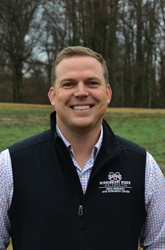 Drew M. Gholson serves as coordinator for the National Center for Alluvial Aquifer Research and Extension irrigation specialist at Mississippi State University, located at the Delta Research and Extension Center in Stoneville. His responsibilities include conceiving, developing, and promoting the adoption of profitable irrigation strategies that conserve water, maintain soil resources, and improve water quality. Drew resides in Leland, Mississippi, with his wife and two children.
Drew M. Gholson serves as coordinator for the National Center for Alluvial Aquifer Research and Extension irrigation specialist at Mississippi State University, located at the Delta Research and Extension Center in Stoneville. His responsibilities include conceiving, developing, and promoting the adoption of profitable irrigation strategies that conserve water, maintain soil resources, and improve water quality. Drew resides in Leland, Mississippi, with his wife and two children.
